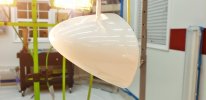Blasted the truck
Washed
Water borne cleaner
SPI epoxy 2 coats
Body fill skim coat
3 coats of 2k primer
I’m done blocking and now have a few bare metal burn through spots.
Before someone suggests epoxy, I lost my temperature window last week. my barn will have a low of 55 at best in the evening's with 78 as the high.
Can I get away with 2k? Or should I leave bare and rely on my reduced epoxy as a sealer?
Washed
Water borne cleaner
SPI epoxy 2 coats
Body fill skim coat
3 coats of 2k primer
I’m done blocking and now have a few bare metal burn through spots.
Before someone suggests epoxy, I lost my temperature window last week. my barn will have a low of 55 at best in the evening's with 78 as the high.
Can I get away with 2k? Or should I leave bare and rely on my reduced epoxy as a sealer?

